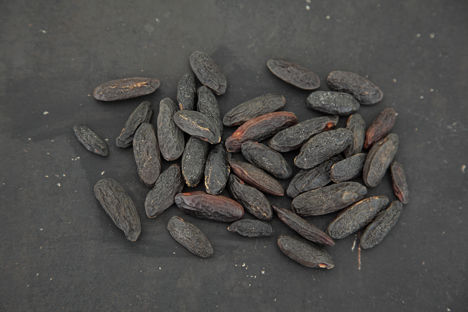Tonka beans are an exotic ingredient — once associated with French haute cuisine, but now creeping into more and more home pantries. The beans are about an inch-long, and resemble a woody raisin, with a lacquered, wrinkled exterior, and softer brown centre. Tonka's most distinctive feature though is their enormous potency — heady vanilla flavours, with oily clove aromas, and perfumed magnolia, sandalwood notes.
The beans grow on the flowering Cumaru tree, most often found in Venezuela, Guyana, Brazil and other countries throughout north-east region of South America. Tonka's strong scent means that it has been coveted by the perfume industry for centuries — starring in world-renowned products.
The tonka bean smell comes from a chemical compound called 'coumarin'. As there's an all-out ban on any ingredients containing coumarin in America, there is lots of misinformation circulating about tonka beans' toxicity. The reality is that it would take the equivalent of 30 whole tonka beans for the coumarin levels to become dangerous — and as the shavings of a single bean stretch to round 25-50 servings, cooks shouldn't lose too much sleep over it. Tonka beans aren't yet a mainstream ingredient, so online spice specialists are the best place to track them down. Use sparingly, and store the tonka beans in a tightly-sealed container, as you would with any other spice.
How to cook with tonka bean
Grate tonka beans with a microplane, as you would with nutmeg, to create an intensely-flavoured powder. The tonka bean powder can be used like any other dry spice, for example it might be mixed with white flour to make a tonka-flavoured bread, mixed with icing sugar to make a tonka-flavoured macaroon, or mixed with all spice to flavour a bread and butter pudding.
Tonka bean is most often used to infuse liquids though, like milks, creams and custards. The shavings are added to the liquid, and stirred on a medium-heat. Cooks should be careful not to boil furiously though, as this will alter the tonka flavour.
Whole tonka beans can also be used to infuse spirits or sugar syrups. Adding a whole bean to a jar of sugar or tin of coffee — as you would with a vanilla pod — will also introduce distinctive new flavours.
What tonka bean goes with
Tonka is a natural pairing with chocolate, and sits beautifully alongside sweet fruits like strawberries and apricots. Tonka's complex flavour also make it an interesting cocktail ingredient, with many of the big, spiced notes overlapping with whiskeys and cognacs.
Much like vanilla, tonka beans are most often used in a sweet dishes — but the more experimental cook might find that the flavours work in a savoury context too. Vanilla, for example, is often used in Madagascan fish dishes — and tonka would suit similar recipes, stirred into a jus, used to flavour mayonnaise or used to spike a savoury sorbet.
Get in touch
Please sign in or register to send a comment to Great British Chefs.



